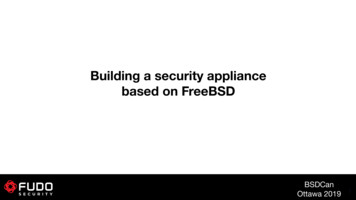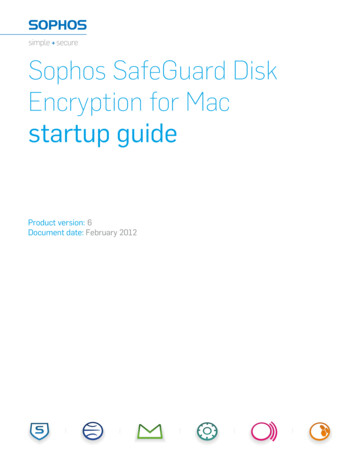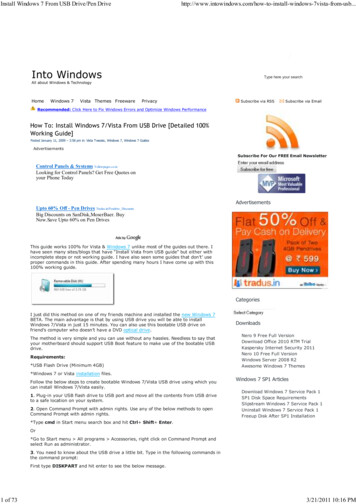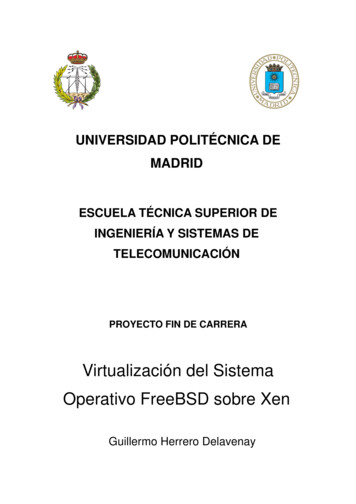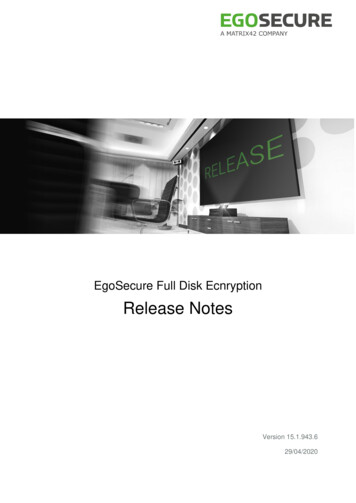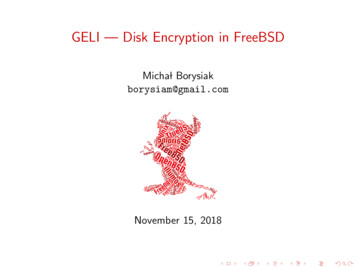
Transcription
GELI — Disk Encryption in FreeBSDMichal Borysiakborysiam@gmail.comNovember 15, 2018
Disk encryption facilities in FreeBSDIGBDE (GEOM-based Disk Encryption)IIIIIIFreeBSD 5, 2003Poul-Henning KampGEOM module in the kernel gbde(4)User space tool gbde(8)Creates new device with .bde suffixGELI (GEOM eli)IIIIIFreeBSD 6, 2005Pawel Jakub DawidekGEOM module in the kernelUser space tool geli(8)Creates new device with .eli suffixIOperates on sector levelINew devices are created to allow plain text access to the data
The GEOM frameworkIStandardized way to access storage layersIFreeBSD 5, 2003IPoul-Henning KampISet of GEOM classesIClasses can be freely stackable in any orderIAbstraction of an I/O request transformationITransformations: striping, mirroring, partitioning, encryptionIProviders and consumersIAuto discovery
GBDEIMaster key (2048 random bits) is located in a random placeon the GEOM provider, and its location is stored in a lock fileIThe lock file is encrypted using a user password and shouldbe stored separatelyIUp to 4 independent user secrets (lock sectors)IEach sector is encrypted using AES-CBC-128 and a randomsector keyIThe sector key is encrypted using a key derived from themaster key and the sector numberIDisk space overhead to store per-sector keysINon-atomic disk updates, since sector keys are storedseparately from dataIDoes not support mounting encrypted device in the / filesystem
GELIISimple sector-to-sector encryptionITo perform symmetric cryptography on sectors a randommaster key is chosenIThe master key is encrypted using user key and stored inthe last sector of the GEOM providerIUp to two encrypted copies of the master key can be storedin the sectorIUser key consists of up to two components: a userpassphrase and a key fileIPassphrase is strengthened using PKCS #5: Password-BasedCryptography Specification 2.0 (RFC 2898)ICan perform verification of data integrity
GELIIAutomatically takes advantage of hardware acceleration ofcryptographic operations thanks to utilization of thecrypto(9) frameworkISupports multiple encryption algorithms (AES-XTS,AES-CBS, Blowfish-CBC, Camellia-CBC, 3DES-CBC) anddifferent key lengthsIAllows to mount encrypted device in the / file systemISince FreeBSD 11 supports booting from encrypted partitions
GELI full disk encryption before FreeBSD 11ISome part of the system had to be left unencrypted(i.e. /boot directory)ITogether with a key file, this part was placed on a separatedevice which user always carried around (e.g. flash memory)ISwap partition encrypted using one-time keyFS typefreebsd-bootfreebsd-zfsfreebsd-swapMount ev/ada0p1/dev/ada0p1.eli/dev/ada0p2/dev/ada0p2.eli
GELI full disk encryption since FreeBSD 11IThanks to Allan Jude boot loader can now perform GELIdecryptionIWhole system can be installed on one ZFS poolIAllows ZFS BE to be used with full disk encryptionFS Typefreebsd-bootfreebsd-zfsMount /ada0p2.eli/dev/ada0p3/dev/ada0p3.eli
GELI encryption in a ZFS volume# Create a block device.zfs create -V 256M zroot/test# Create a random 4k key file.dd if /dev/random of /tmp/test.key bs 4k count 1# Initialize and attach encrypted disk.geli init -K /tmp/test.key /dev/zvol/zroot/testgeli attach -k /tmp/test.key /dev/zvol/zroot/test# A new device appeared.ls /dev/zvol/zroot/test.eli# We can create a new filesystem on the device.zpool create -m /tmp/ztest ztest /dev/zvol/zroot/test.eli
GELI backup and restore metadata# Backup GELI metadata.geli backup /dev/zvol/zroot/test /tmp/test.eli# Clear GELI metadata.geli clear /dev/zvol/zroot/test# Try to attach GELI device. It is not possible, since GELI# cannot find its metadata on the device.geli attach -k /tmp/test.key /dev/zvol/zroot/test# Restore GELI metadata.geli restore /tmp/test.eli /dev/zvol/zroot/test# Now we can attach GELI device and import the pool.geli attach -k /tmp/test.key /dev/zvol/zroot/testzpool import
GELI resize the provider# Resize ZFS volume.zfs set volsize 512M zroot/test# Now we cannot attach GELI device, because GELI cannot# find its metadata on the device.geli attach /dev/zvol/zroot/test# We need to inform GELI about previous size of the device.geli resize -s 256M /dev/zvol/zroot/test# Now we can attach GELI device and import the pool.geli attach -k /tmp/test.key /dev/zvol/zroot/testzpool import
Thank you for your attention!
GELI full disk encryption before FreeBSD 11 I Some part of the system had to be left unencrypted (i.e. /boot directory) I Together with a key le, this part was placed on a separate device which user always carried around (e.g. ash memory) I Swap partition encrypted using one-time key FS type Mount point Device
